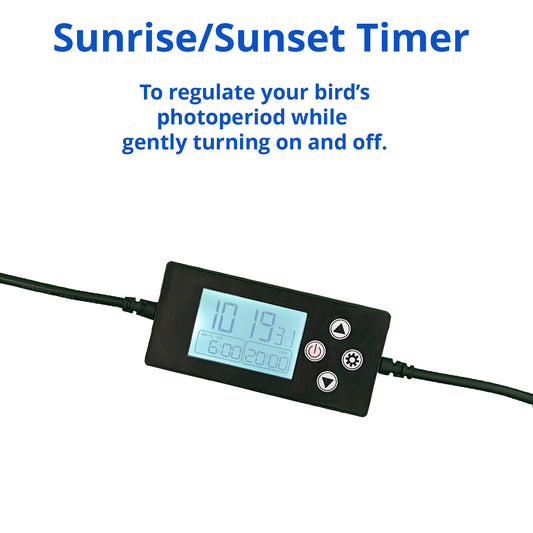How to Create a Lighting Routine That Matches Nature
Share
 Your bird may live indoors, but its instincts still follow the sun. In the wild, birds wake with the light and wind down with the setting sun. Creating a consistent, natural-feeling light schedule indoors helps support that rhythm and makes their environment feel more stable.
Your bird may live indoors, but its instincts still follow the sun. In the wild, birds wake with the light and wind down with the setting sun. Creating a consistent, natural-feeling light schedule indoors helps support that rhythm and makes their environment feel more stable.
Here’s how to design a lighting routine that mirrors the rhythm birds evolved with, without relying on household lighting or unpredictable windows.
The Daily Cycle: 10–12 Hours of Light
Birds thrive on regularity. That means a structured light cycle: 10–12 hours of bright, consistent light followed by 12–14 hours of darkness or low light.
This rhythm helps signal when it’s time to be active, play, forage, and when it’s time to wind down. Skipping this step or relying on natural room light alone often results in an irregular routine that doesn’t support the bird’s natural internal clock.
Step 1: Use a Cage-Mounted Bird Light
Most ceiling lights or decorative lamps don’t deliver enough brightness into a cage, especially through bars and shadows. Even a well-lit room won’t provide the light intensity or placement birds prefer inside their enclosure.
That’s why cage-mounted lighting is essential. Lights like HappyBird are designed to be installed directly onto the cage or just above it, ensuring the bird receives light where it lives and interacts.
Key features to look for:
- Flicker-free performance (important for bird vision)
- Broad-spectrum visible light (no artificial UVB)
- Safe 24VDC low-voltage operation
- Stainless steel cable protection (in case of chewing)
Step 2: Automate with Timers
Consistency is key. Using a timer to control when your bird’s light turns on and off removes the guesswork and ensures your bird experiences the same sunrise and sunset every day.
Recommended schedule:
☀️ Lights on: 7:00–8:00 AM
🌙 Lights off: 7:00–8:00 PM
Adjust to match your household rhythm - just keep it consistent.
Step 3: Avoid Inconsistent Light Sources
Household lights, TVs, and sunlight through windows can create an inconsistent or confusing environment, especially in the evening. To avoid disruption:
- Turn off cage-mounted lights at the same time each day
- Minimize background light after “bedtime”
- Avoid placing the cage near screens or hallway lights that stay on at night
Step 4: Align with Seasons — Without Shortening the Day
In winter, natural daylight hours shrink — but your bird’s internal rhythm doesn’t. Artificial light helps keep day length consistent year-round, avoiding confusion caused by darker mornings and early sunsets.
Keeping your lighting on a timer, even during the darker seasons, ensures your bird receives the same full day, no matter the weather.
Bonus Tip: Simulate Natural Transitions
If possible, gradually transition lights on and off (using dimmers or smart timers) to mimic dawn and dusk. While not essential, this adds an extra layer of comfort by simulating the natural rise and fall of sunlight.
Final Thoughts
Creating a natural-feeling light routine indoors doesn’t require guessing or sunlight - it requires consistency, structure, and the right tools. With the right bird-specific lighting and a simple timer, you can reflect nature’s rhythm in your own home.
Birds may not live outside, but their instincts still follow the sun. Help them stay in sync by making lighting part of your daily routine, not an afterthought.



